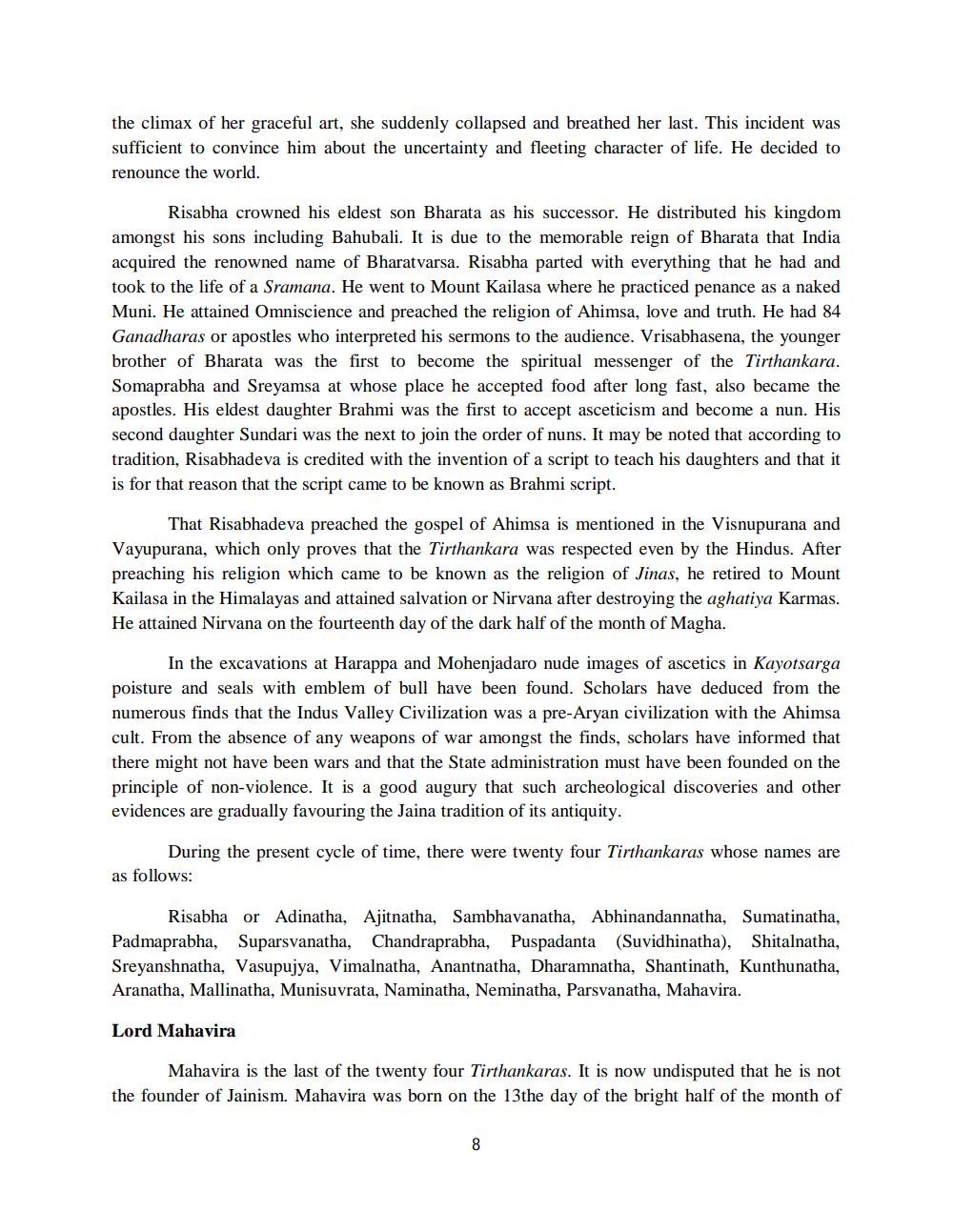Book Title: Basic Principles Of Jainism Author(s): Narayan Lal Kachhara Publisher: Narayan Lal Kachhara View full book textPage 8
________________ the climax of her graceful art, she suddenly collapsed and breathed her last. This incident was sufficient to convince him about the uncertainty and fleeting character of life. He decided to renounce the world. Risabha crowned his eldest son Bharata as his successor. He distributed his kingdom amongst his sons including Bahubali. It is due to the memorable reign of Bharata that India acquired the renowned name of Bharatvarsa. Risabha parted with everything that he had and took to the life of a Sramana. He went to Mount Kailasa where he practiced penance as a naked Muni. He attained Omniscience and preached the religion of Ahimsa, love and truth. He had 84 Ganadharas or apostles who interpreted his sermons to the audience. Vrisabhasena, the younger brother of Bharata was the first to become the spiritual messenger of the Tirthankara. Somaprabha and Sreyamsa at whose place he accepted food after long fast, also became the apostles. His eldest daughter Brahmi was the first to accept asceticism and become a nun. His second daughter Sundari was the next to join the order of nuns. It may be noted that according to tradition, Risabhadeva is credited with the invention of a script to teach his daughters and that it is for that reason that the script came to be known as Brahmi script. That Risabhadeva preached the gospel of Ahimsa is mentioned in the Visnupurana and Vayupurana, which only proves that the Tirthankara was respected even by the Hindus. After preaching his religion which came to be known as the religion of Jinas, he retired to Mount Kailasa in the Himalayas and attained salvation or Nirvana after destroying the aghatiya Karmas. He attained Nirvana on the fourteenth day of the dark half of the month of Magha. In the excavations at Harappa and Mohenjadaro nude images of ascetics in Kayotsarga poisture and seals with emblem of bull have been found. Scholars have deduced from the numerous finds that the Indus Valley Civilization was a pre-Aryan civilization with the Ahimsa cult. From the absence of any weapons of war amongst the finds, scholars have informed that there might not have been wars and that the State administration must have been founded on the principle of non-violence. It is a good augury that such archeological discoveries and other evidences are gradually favouring the Jaina tradition of its antiquity. During the present cycle of time, there were twenty four Tirthankaras whose names are as follows: Risabha or Adinatha, Ajitnatha, Sambhavanatha, Abhinandannatha, Sumatinatha, Padmaprabha, Suparsvanatha, Chandraprabha, Puspadanta (Suvidhinatha), Shitalnatha, Sreyanshnatha, Vasupujya, Vimalnatha, Anantnatha, Dharamnatha, Shantinath, Kunthunatha, Aranatha, Mallinatha, Munisuvrata, Naminatha, Neminatha, Parsvanatha, Mahavira. Lord Mahavira Mahavira is the last of the twenty four Tirthankaras. It is now undisputed that he is not the founder of Jainism. Mahavira was born on the 13the day of the bright half of the month ofPage Navigation
1 ... 6 7 8 9 10 11 12 13 14 15 16 17 18 19 20 21 22 23 24 25 26 27 28 29 30 31 32 33 34 35 36 37 38 39 40 41 42 43 44 45 46 47 48 49 50 51 52 53 54 55 56 57 58 59 60 61 62 63 64 65 66 67 68 69 70 71 72 73 74 75 76 77 78 79 80 81 82 ... 106
